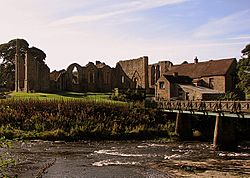Finchale Priory facts for kids

Finchale Priory on the bank of the River Wear
|
|
| Monastery information | |
|---|---|
| Order | Benedictine |
| Established | 1196 |
| Disestablished | 1535 |
| Mother house | Durham Priory |
| Diocese | Durham |
| People | |
| Founder(s) | Bishop Hugh Pudsey |
| Important associated figures | Godric of Finchale |
| Site | |
| Location | Framwellgate Moor, County Durham, England |
| Visible remains | foundations of 12th century chapel, extensive remains of later monastic complex |
| Public access | yes (English Heritage) |
Finchale Priory (pronounced finkle) was a special place where monks lived. It was a Benedictine priory built in the 13th century. Today, you can still see its ruins by the River Wear, about four miles from Durham, England. This old building is very important, so it's called a Grade I listed building. It was a home for monks until it closed down in 1535.
Contents
Discovering Finchale Priory's History
The First Hermit: Godric of Finchale
Long ago, in the early 1100s, a man named Godric came to live at Finchale. He created a quiet retreat called a hermitage. This hermitage was dedicated to Saint John the Baptist.
Godric's friends wrote about his life. They said he lived a very simple life for 50 years. He often slept outside and didn't wear fancy clothes. He also ate very plain food. People said Godric slept on the ground with only stones and branches for comfort.
Later in his life, Godric became very sick. For almost ten years before he died in 1170, monks from Durham cared for him. He was first buried in Durham. But later, his remains were moved to the church at Finchale.
How Finchale Priory Began
After Godric passed away, two monks from Durham moved to Finchale. There was already a church, a mill, a dam, and a fish pond there. In 1196, the hermitage church became known as Finchale Priory.
This was the year that Bishop Hugh Pudsey and his son Henry gave money and land to the priory. This money helped support eight monks and their leader, called a prior. Bishop Pudsey chose Thomas, a monk from Durham, to be the first prior. Finchale Priory was never super rich. But by the mid-1400s, it was the wealthiest of Durham's smaller monasteries.
Building the Priory Church
The church at Finchale was built over many years, starting around 1200. It took more than a century to finish! One big change happened in the 1360s and 1370s. Workers made the main part of the church narrower by removing the side sections.
Building work continued at Finchale until the mid-1400s. The guest house, where visitors stayed, and part of the prior's home were built around this time.
Life at the Priory and Its End
Finchale remained a priory until 1536. This was when many smaller monasteries were closed down. During its history, Finchale had 52 different priors. We even have old records of their money from 1303 to 1535!
For much of its time, the priory was a resting place for monks from Durham. Four Durham monks would visit Finchale for three weeks at a time. They would join the four monks who lived there permanently. During these breaks, the Durham monks could relax and enjoy more freedom than usual.
Exploring the Priory Buildings Today
You can still see parts of the early 12th-century stone chapel of St John the Baptist. This is where Godric of Finchale was buried. Some of the first buildings, made for the monks who started the priory, are also still there. The main monastery buildings were built in the late 1200s. More changes and additions were made over the next 300 years.
You can see beautiful carvings on the old columns. There are also fancy stone patterns in the church's arches. On the south wall, you'll find a double piscina (a basin for washing holy vessels) and two carved seats.
English Heritage looks after the buildings and the land right around them. The area you walk through to get to the priory is now a caravan park.

